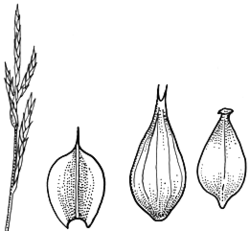Carex bichenoviana Boott APNI* 
Description: Rhizome long; shoots loosely tufted. Culms erect, trigonous, smooth, 20–40 cm long, 1.0–1.8 mm diam.
Leaves exceeding culms, to 60 cm long; blade 2–8 mm wide; sheath dark yellow-brown, occasionally red-tinged; ligule obtuse to truncate or retuse.
Inflorescence erect, narrow, often longer than the culm, 6–30 cm long, with few to numerous spikes clustered or solitary at nodes; lowest involucral bracts exceeding inflorescence. Spikes sessile, erect at maturity, 1–5 cm long; upper 3–15 spikes male, ± contiguous; lowest 1–7 spikes female or androgynous, ± distant. Glumes obtuse to retuse or acute, mostly shortly mucronate, dark to very dark red-brown, with whitish margins near apex; female glumes 3–4 mm long. Perigynia (utricles) broad-ovoid to ellipsoid, not nerved or with few, more or less impressed nerves, 4–5 mm long, 2.0–2.5 mm diam., glabrous, thick, corky, inflated, yellow-brown, usually tinged dark red-brown; beak c. 1 mm long, with apex 2-fid. Anthers 2.5–4.8 mm long excluding appendage to 0.3 mm long. Style 3-fid.
Nut broad-ellipsoid, trigonous in cross section, yellow-brown to red-brown.
Flowering: spring–summer.
Distribution and occurrence: South from Glen Innes on the tablelands, extending west to Condobolin. Grows in seasonally moist places such as stream banks, on sandy to silty soils.
NSW subdivisions: NT, CT, ST, NWS, CWS, SWS, SWP
Other Australian states: Vic. Tas. S.A.
Inland counterpart of C. pumila, from which it differs in the rather regular antrorse prickles on the leaf margins (C. pumila has irregularly blunt prickles on the margins of leaves and bracts), the darker red-brown glumes, which are mucronate, more obtuse and often erose. In specimens from the tablelands, the inflorescence is smaller and leaves are curly toward the apex, thickened and narrow.
Text by K. L. Wilson (1993); edited KL Wilson (July 2016; September 2017)
Taxon concept: Flora of NSW 4 (1993)
APNI* Provides a link to the Australian Plant Name Index (hosted by the Australian National Botanic Gardens) for comprehensive bibliographic data
***The AVH map option provides a detailed interactive Australia wide distribution map drawn from collections held by all major Australian herbaria participating in the Australian Virtual Herbarium project.
|


